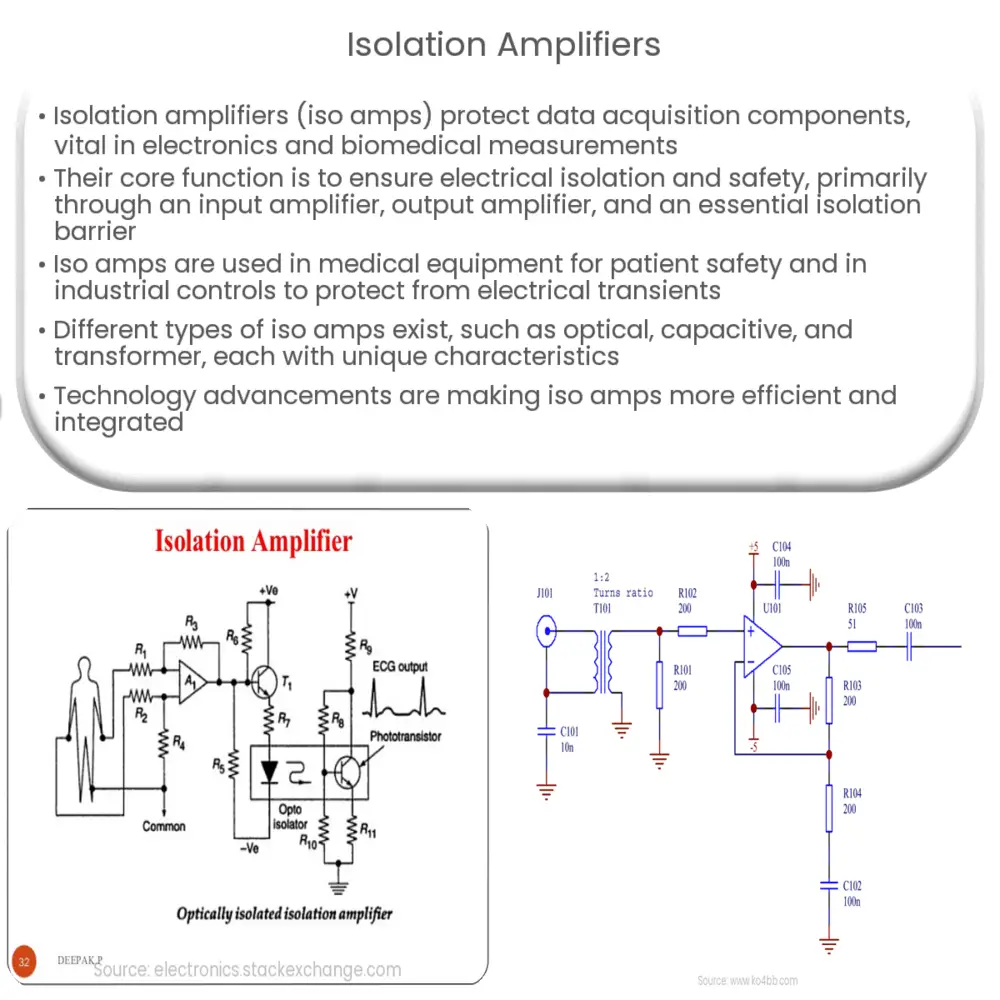Explore the essential role of isolation amplifiers in electronics and biomedical measurements, their components, types, and the future of iso amp technology.

Introduction to Isolation Amplifiers
An isolation amplifier (also known as an ‘iso amp’) plays a crucial role in protecting data acquisition components. It is an essential device in the domain of electronics and biomedical measurements, offering a range of applications from industrial equipment to medical devices.
Understanding Isolation Amplifiers
An isolation amplifier’s core functionality is to offer electrical isolation and an electrical safety barrier. They are designed to isolate the input and output signals, thereby ensuring accurate data transmission and safeguarding sensitive devices and operators from transient electrical spikes. This is achieved by isolating two portions of an electrical system, enabling power or data to be transferred between two circuits that need to remain electrically isolated from each other.
Components of an Isolation Amplifier
There are three key components within an isolation amplifier:
- The input amplifier,
- The output amplifier, and
- The isolation barrier.
Both the input and output amplifiers are typically operational amplifiers (Op-amps) that can amplify a wide range of frequencies. The isolation barrier, however, is the defining component of an iso amp.
Role of the Isolation Barrier
The isolation barrier within an isolation amplifier can be created using different techniques such as optical isolation, transformer coupling, or capacitive coupling. This barrier ensures that high voltages or transient surges on the input side do not damage the components on the output side. Also, it prevents ground loops and noise from affecting the signal quality. Ultimately, the isolation barrier ensures that sensitive devices remain safe, and signal integrity is maintained, regardless of the conditions on the input side.
Applications of Isolation Amplifiers
Isolation amplifiers are found in a myriad of applications due to their protective nature and their ability to maintain signal integrity. Some primary examples include:
- Medical equipment – Here, isolation amplifiers are used to safeguard patients from potential electrical shock, ensuring accurate and safe data transfer.
- Industrial controls and systems – In these environments, iso amps protect sensitive equipment and components from electrical transients and noise that can occur due to high power equipment.
Types of Isolation Amplifiers
Isolation amplifiers come in several different types. The most common ones are:
- Optical Isolation Amplifiers: These utilize an optocoupler for transferring electrical signals by means of light waves. They offer a high degree of isolation but can be susceptible to temperature-induced performance changes.
- Capacitive Isolation Amplifiers: These amplifiers utilize a capacitive barrier for signal transfer, which makes them immune to magnetic fields. However, they can be impacted by large electric fields.
- Transformer Isolation Amplifiers: These use a transformer for signal transfer. Transformer isolation amplifiers are usually robust and offer high isolation levels. However, they might not be ideal for high-frequency applications.
Choosing the Right Isolation Amplifier
When selecting an isolation amplifier, several factors should be considered, such as:
- The level of isolation required
- The bandwidth and speed of the amplifier
- The amount of power the amplifier consumes
- The operating temperature range
Considering these factors will ensure that the chosen isolation amplifier can meet the specific requirements of your application.
Advancements in Isolation Amplifier Technology
Technology advancements have led to the development of highly efficient and more compact isolation amplifiers. There is a trend towards integration where isolation amplifiers are integrated with other functionalities like data converters, leading to reduced component count and board space. Further advancements in isolation technology promise to enhance isolation amplifier performance in terms of power efficiency, speed, and safety.
Conclusion
In conclusion, isolation amplifiers are integral to numerous applications where signal integrity, safety, and electrical isolation are of paramount importance. Whether it’s medical equipment, industrial controls, or any other sensitive electronic device, isolation amplifiers provide the required protection and signal quality maintenance. As technology continues to advance, we can expect the capabilities of isolation amplifiers to expand, providing even greater performance and protection in the future.

